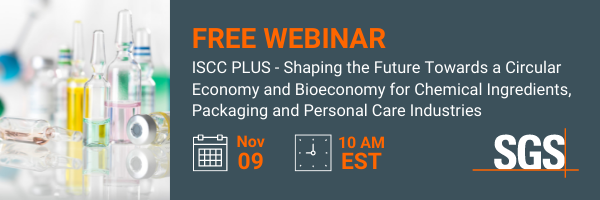Regulations & EHS&S
Endocrine disrupting materials and EU legislation 16th January 2020
By Rémi Vacherot, Senior Toxicologist at Yordas Group
Rémi Vacherot, Senior Toxicologist at Yordas Group, makes sense of the regulatory provisions for endocrine disruptor chemicals in
Rémi Vacherot, Senior Toxicologist at Yordas Group, makes sense of the regulatory provisions for endocrine disruptor chemicals in current EU legislation.
The endocrine system is a complex network of glands, hormones and receptors involved in the control of numerous bodily functions such as metabolism, reproduction, behaviour and immunity. Endocrine Disruptor Chemicals (EDCs) are substances interfering with this system and leading to adverse effects in humans and wildlife.
The recent release of Commission Delegated Regulation (EU) 2017/21001 on Biocidal Products and Commission Regulation (EU) 2018/6052 on Plant Protection Products shows a strong commitment from the EU to establish science-based criteria to identify and control EDCs in the Union. Indeed, these two Regulations are the first to set out criteria to identify an EDC:
- It shows an adverse effect in an intact organism or its progeny, resulting in an impairment of functional capacity, an impairment of the capacity to compensate for additional stress or an increase in susceptibility to other influences, and
- It has an endocrine mode of action, and
- The adverse effect is a consequence of the endocrine mode of action.
These criteria are based on the definition used by the World Health Organization (WHO) and the Organisation for Economic Co-operation and Development (OECD).
While these Regulations set out clear criteria for the identification of EDCs in Biocidal or Plant Protection Products, additional regulatory provisions for EDCs are covered in other pieces of EU legislation.
EU legislation
The EU Regulations on Biocidal and Plant Protection Products are currently the only ones requiring an assessment of the ED properties of active substances as part of their evaluation for approval or renewal, and setting criteria to identify them. A Guidance for the identification of EDCs was released in 2018 by ECHA and EFSA with a focus on these products in order to support Competent Authorities (CA) and the industry. However, identifying a substance as an EDC under these Regulations does not mean that it cannot be approved, if it can be proven that exposure is negligible or if it is required to address some specific threats.
Several EU Legislations also include specific provisions regarding EDCs. Among these Legislations, the Water Framework Directive (Directive No 2000/60/EC) and the Medical Devices Regulation (Regulation (EC) No. 2017/745) do not define them nor include mechanisms allowing to evaluate a substance for potential ED properties.
Under REACH (Regulation (EC) No. 1907/2006), the Cosmetic Products Regulation (Regulation (EC) No. 1223/2009), the Food Contact Material Regulation (Regulation (EC) No. 1935/2004), and the Toy Safety Directive (Directive 2009/48/EC), substances with potential ED properties may be assessed as they could represent a risk to human health and/or the environment. However, while there are guidance documents setting out criteria for identifying EDC in the context of the Cosmetic Products Regulation, the other Regulations and Directive are not associated to such criteria.
The aforementioned guidance documents are based on the OECD Revised Guidance Document 150 on Standardised Test Guidelines for Evaluating Chemicals for Endocrine Disruption. It is expected that the other EU Legislations use the OECD Guidance Document as well for the purpose of identifying EDCs.
Challenges in the EU
There are currently several issues identified in the EU regarding EDCs and the new Regulations addressing them.
The EDC assessment introduced for biocidal and plant protection products has resulted in a delay in the ongoing evaluation process of active substances. Moreover, the data generated or made available for the purpose of the applications for approval of these active substances may not be sufficient to conclude on their EDC properties and additional studies may be required. This could potentially lead to a substantial number of animal studies being eventually conducted for that purpose.
These two Regulations include provisions to approve some EDCs if it can be demonstrated that the risk arising from the exposure is negligible. However, there is no current consensus regarding setting safe levels below which EDCs would not be expected to disrupt the endocrine system. A conservative approach would be to consider that it is not possible to set such safe levels, implying that risk arising from the exposure to EDC could never be deemed as negligible.
Overall, there is a concern and uneasiness among the chemical industry that the assessment of EDCs may be too precautionary, which would assume a substance to be an EDC until proved otherwise. It is becoming critical to properly identify EDCs while avoiding false positive, and to determine the exposure to EDCs and to provide a justification when it is considered appropriate to use such substances.
Potential EDC or substances already identified as EDC represent a new challenge for the industry in the EU as measures and approaches to regulate these type of substance are introduced in EU regulations.
References:
- Commission Delegated Regulation (EU) 2017/2100 of 4 September 2017 setting out scientific criteria for the determination of endocrine-disrupting properties pursuant to Regulation (EU) No 528/2012 of the European Parliament and Council.
- Commission Regulation (EU) 2018/605 of 19 April 2018 amending Annex II to Regulation (EC) No 1107/2009 by setting out scientific criteria for the determination of endocrine disrupting properties.
Author:
Rémi Vacherot, PharmD, Senior Toxicologist at Yordas Group, Lancaster Environment Centre, Lancaster University, Lancaster LA1 4YQ, UK
T: +44 (0)1524 510278
T: +44 (0)1524 510278



